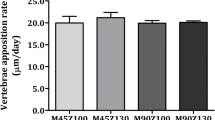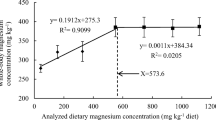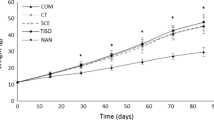Abstract
Trace elements such as Cu, Fe, Mn and Zn are essential minerals in fish diets, especially important at early larval stages. The chemical speciation of these elements directly influences their uptake efficiency and metabolic utilization. In order to optimize the form of trace elements incorporated into larval feed, two experiments were conducted using two commercial fish species, European seabass (Dicentrarchus labrax) and Senegalese sole (Solea senegalensis), and two chemical forms (inorganic and glycinate chelates). Several fish performance parameters were measured, as well as bone status parameters to assess which form of mineral results in optimal fish biological performance. European seabass and Senegalese sole post-larvae were unresponsive (P > 0.05) to dietary treatments in terms of dry weight (DW), standard length (SL), relative growth rate (RGR) or feed conversion rates (FCR) when fed diets supplemented with chelated over inorganic trace minerals. This study suggests that replacing dietary inorganic mineral supplementation by their organic glycinate-chelated forms brings no beneficial effects on somatic growth and bone development in Senegalese sole and European seabass post-larvae fed high-quality commercial microdiets. Additionally, we show that mineral leaching from diets can be significant, but the use of chelated minerals can potentially mitigate this leaching phenomenon. Therefore, the selection of the dietary mineral form should take into account not only their economic value, but also their biological effect and environmental impact. Data generated in this trial provides new knowledge in trace mineral nutrition of early-stage marine fish.





Similar content being viewed by others
Data Availability
The data are available from the corresponding author based on reasonable requests.
References
Georgakopoulou E, Katharios P, Divanach P, Koumoundouros G (2010) Effect of temperature on the development of skeletal deformities in Gilthead seabream (Sparus aurata Linnaeus, 1758). Aquaculture 308:13–19. https://doi.org/10.1016/j.aquaculture.2010.08.006
Boglione C, Gavaia P, Koumoundouros G et al (2013) Skeletal anomalies in reared European fish larvae and juveniles. Part 1: normal and anomalous skeletogenic processes. Rev Aquac 5:S99–S120. https://doi.org/10.1111/raq.12015
Boglione C, Gisbert E, Gavaia P et al (2013) Skeletal anomalies in reared European fish larvae and juveniles. Part 2: main typologies, occurrences and causative factors. Rev Aquac 5:S121–S167. https://doi.org/10.1111/raq.12016
Lall SP, Lewis-McCrea L (2007) Role of nutrients in skeletal metabolism and pathology in fish - an overview. Aquaculture 267:3–19. https://doi.org/10.1016/j.aquaculture.2007.02.053
Cahu C, Zambonino Infante J, Takeuchi T (2003) Nutritional components affecting skeletal development in fish larvae. Aquaculture 227:245–258. https://doi.org/10.1016/S0044-8486(03)00507-6
Mazurais D, Darias MJ, Le Gall MM et al (2008) Dietary vitamin mix levels influence the ossification process in European sea bass (Dicentrarchus labrax) larvae. Am J Physiol Integr Comp Physiol 294:R520–R527. https://doi.org/10.1152/ajpregu.00659.2007
Darias MJ, Mazurais D, Koumoundouros G et al (2010) Dietary vitamin D3 affects digestive system ontogenesis and ossification in European sea bass (Dicentrachus labrax, Linnaeus, 1758). Aquaculture 298:300–307. https://doi.org/10.1016/j.aquaculture.2009.11.002
Hamre K, Yúfera M, Rønnestad I et al (2013) Fish larval nutrition and feed formulation: knowledge gaps and bottlenecks for advances in larval rearing. Rev Aquac 5:S26–S58. https://doi.org/10.1111/j.1753-5131.2012.01086.x
Lall SP, Kaushik SJ (2021) Nutrition and metabolism of minerals in fish. Animals 11(9):2711
Lall SP (2002) The minerals. In: Hardy JE, Halver R (eds) Fish nutrition, 3rd edn. Academic Press, San Diego, pp 259–308
Watanabe T, Kiron V, Satoh S (1997) Trace minerals in fish nutrition. Aquaculture 151:185–207. https://doi.org/10.1016/S0044-8486(96)01503-7
NRC (National Research Council) (2011) Minerals. In: Nutrient requirements of fish and shrimp. The National Academies Press, Washington, DC, pp 163–185
Apines MJS, Satoh S, Kiron V et al (2003) Availability of supplemental amino acid-chelated trace elements in diets containing tricalcium phosphate and phytate to rainbow trout, Oncorhynchus mykiss. Aquaculture 225:431–444. https://doi.org/10.1016/S0044-8486(03)00307-7
Apines-Amar MJS, Satoh S, Caipang CMA et al (2004) Amino acid-chelate: a better source of Zn, Mn and Cu for rainbow trout, Oncorhynchus mykiss. Aquaculture 240:345–358. https://doi.org/10.1016/j.aquaculture.2004.01.032
Katya K, Lee S, Bharadwaj AS et al (2016) Effects of inorganic and chelated trace mineral (Cu, Zn, Mn and Fe) premixes in marine rockfish, Sebastes schlegeli (Hilgendorf), fed diets containing phytic acid. Aquac Res 48:1–9. https://doi.org/10.1111/are.13236
Paripatananont T, Lovell RT (1997) Comparative net absorption of chelated and inorganic trace minerals in channel catfish Ictalurus punctatus diets. J World Aquac Soc 28:62–67. https://doi.org/10.1111/j.1749-7345.1997.tb00962.x
Wang C, Lovell RT (1997) Organic selenium sources, selenomethionine and selenoyeast, have higher bioavailability than an inorganic selenium source, sodium selenite, in diets for channel catfish (Ictalurus punctatus). Aquaculture 152:223–234. https://doi.org/10.1016/S0044-8486(96)01523-2
Antony Jesu Prabhu P, Schrama JW, Kaushik SJ et al (2016) Mineral requirements of fish: a systematic review. Rev Aquac 8:172–219. https://doi.org/10.1111/raq.12090
Terova G, Rimoldi S, Izquierdo M et al (2018) Nano-delivery of trace minerals for marine fish larvae: influence on skeletal ossification, and the expression of genes involved in intestinal transport of minerals, osteoblast differentiation, and oxidative stress response. Fish Physiol Biochem 44(5):1375–1391. https://doi.org/10.1007/s10695-018-0528-7
Izquierdo MS, Ghrab W, Roo J et al (2016) Organic, inorganic and nanoparticles of Se, Zn and Mn in early weaning diets for gilthead seabream (Sparus aurata; Linnaeus, 1758). Aquac Res 48:1–16. https://doi.org/10.1111/are.13119
Viegas MN, Salgado MA, Aguiar C et al (2021) Effect of dietary manganese and zinc levels on growth and bone status of Senegalese sole (Solea senegalensis) post-larvae. Biol Trace Elem Res 199:2012–2021. https://doi.org/10.1007/s12011-020-02307-4
Navarro DB, Rubio VC, Luz RK et al (2009) Daily feeding rhythms of Senegalese sole under laboratory and farming conditions using self-feeding systems. Aquaculture 291:130–135. https://doi.org/10.1016/j.aquaculture.2009.02.039
AOAC (ed) (2006) Official methods of analysis: revision 1, 2006, 18th edn. AOAC International, Gaithersburg Maryland, USA
Bassett JHD, van der Spek A, Gogakos A, Williams G (2012) Quantitative X-ray imaging of rodent bone by Faxitron. In: Helfrich MH, Ralston SH (eds) Bone Research Protocols SE - 29. Humana Press, pp 499–506
Mabilleau G, Mieczkowska A, Irwin N et al (2013) Optimal bone mechanical and material properties require a functional glucagon-like peptide-1 receptor. J Endocrinol 219:59–68. https://doi.org/10.1530/JOE-13-0146
Boglione C, Pulcini D, Scardi M et al (2014) Skeletal anomaly monitoring in rainbow trout (Oncorhynchus mykiss, Walbaum 1792) reared under different conditions. PLoS One 9:e96983. https://doi.org/10.1371/journal.pone.0096983
Losada AP, de Azevedo AM, Barreiro A et al (2014) Skeletal malformations in Senegalese sole (Solea senegalensis Kaup, 1858): gross morphology and radiographic correlation. J Appl Ichthyol 30:804–808. https://doi.org/10.1111/jai.12524
Ennos R (2007) Statistical and data handling skills in biology. Pearson Prentice Hall
SA MVDCE, Pezzato LE, Barros MM, Padilha PM (2005) Relative bioavailability of zinc in supplemental inorganic and organic sources for Nile tilapia Oreochromis niloticus fingerlings. Aquac Nutr 11:273–281. https://doi.org/10.1111/j.1365-2095.2005.00352.x
Fountoulaki E, Morgane H, Rigos G et al (2010) Evaluation of zinc supplementation in European sea bass (Dicentrarchus labrax) juvenile diets. Aquac Res 41:208–216. https://doi.org/10.1111/j.1365-2109.2010.02503.x
Savolainen LC, Gatlin DM (2010) Evaluation of sulfur amino acid and zinc supplements to soybean-meal-based diets for hybrid striped bass. Aquaculture 307:260–265. https://doi.org/10.1016/j.aquaculture.2010.07.027
Domínguez D, Rimoldi S, Robaina LE et al (2017) Inorganic, organic, and encapsulated minerals in vegetable meal based diets for Sparus aurata (Linnaeus, 1758). PeerJ 5:e3710. https://doi.org/10.7717/peerj.3710
Silva MS, Kröckel S, Jesu Prabhu PA et al (2019) Apparent availability of zinc, selenium and manganese as inorganic metal salts or organic forms in plant-based diets for Atlantic salmon (Salmo salar). Aquaculture 503:562–570. https://doi.org/10.1016/j.aquaculture.2019.01.005
Zhang H, Gilbert ER, Zhang K et al (2017) Uptake of manganese from manganese–lysine complex in the primary rat intestinal epithelial cells. J Anim Physiol Anim Nutr (Berl) 101:147–158. https://doi.org/10.1111/jpn.12430
Yúfera M, Darías MJ (2007) Changes in the gastrointestinal pH from larvae to adult in Senegal sole (Solea senegalensis). Aquaculture 267:94–99. https://doi.org/10.1016/j.aquaculture.2007.02.009
Rønnestad I, Yúfera M, Ueberschar B et al (2013) Feeding behaviour and digestive physiology in larval fish: current knowledge, and gaps and bottlenecks in research. Rev Aquac 5:S59–S98. https://doi.org/10.1111/raq.12010
García-Casal MN, Layrisse M (2001) The effect of change in pH on the solubility of iron bis-glycinate chelate and other iron compounds. Arch Latinoam Nutr 51:35–36
López-alvarado J, Langdonb CJ, Teshima S, Kanazawa A (1994) Effects of coating and encapsulation of crystalline amino acids on leaching in larval feeds. Aquaculture 122:335–346
Yúfera M, Kolkovski S, Fernández-Díaz C, Dabrowski K (2002) Free amino acid leaching from a protein-walled microencapsulated diet for fish larvae. Aquaculture 214:273–287. https://doi.org/10.1016/S0044-8486(01)00902-4
Nordgreen A, Yúfera M, Hamre K (2008) Evaluation of changes in nutrient composition during production of cross-linked protein microencapsulated diets for marine fish larvae and suspension feeders. Aquaculture 285:159–166. https://doi.org/10.1016/j.aquaculture.2008.08.011
Önal U, Langdon C (2004) Characterization of lipid spray beads for delivery of glycine and tyrosine to early marine fish larvae. Aquaculture 233:495–511
Kvåle A, Yúfera M, Nygård E et al (2006) Leaching properties of three different micropaticulate diets and preference of the diets in cod (Gadus morhua L.) larvae. Aquaculture 251:402–415. https://doi.org/10.1016/j.aquaculture.2005.06.002
Kvåle A, Nordgreen AH, Tonheim SK, Hamre K (2007) The problem of meeting dietary protein requirements in intensive aquaculture of marine fish larvae, with emphasis on Atlantic halibut (Hippoglossus hippoglossus L.). Aquac Nutr 13:170–185. https://doi.org/10.1111/j.1365-2095.2007.00464.x
Hamre K (2006) Nutrition in cod (Gadus morhua) larvae and juveniles. ICES J Mar Sci 63:267–274. https://doi.org/10.1016/j.icesjms.2005.11.011
Phillips MJ, Clarke R, Mowat A (1993) Phosphorus leaching from Atlantic salmon diets. Aquac Eng 12:47–54. https://doi.org/10.1016/0144-8609(93)90026-8
Roy LA, Davis DA, Saoud IP, Henry RP (2007) Supplementation of potassium, magnesium and sodium chloride in practical diets for the Pacific white shrimp, Litopenaeus vannamei, reared in low salinity waters. Aquac Nutr 13:104–113. https://doi.org/10.1111/j.1365-2095.2007.00460.x
Berillis P (2015) Factors that can lead to the development of skeletal deformities in fishes: a review. J Fish com 9:17–23
Chanda S, Paul BN, Ghosh K, Giri SS (2015) Dietary essentiality of trace minerals in aquaculture-a review. Agric Rev 36:100–112. https://doi.org/10.5958/0976-0741.2015.00012.4
Nielsen FH (2000) Evolutionary events culminating in specific minerals becoming essential for life. Eur J Nutr 39:62–66. https://doi.org/10.1007/s003940050003
Nguyen VT, Satoh S, Haga Y et al (2008) Effect of zinc and manganese supplementation in Artemia on growth and vertebral deformity in red sea bream (Pagrus major) larvae. Aquaculture 285:184–192. https://doi.org/10.1016/j.aquaculture.2008.08.030
Roberto VP, Martins G, Pereira A et al (2018) Insights from dietary supplementation with zinc and strontium on the skeleton of zebrafish, Danio rerio (Hamilton, 1822) larvae: from morphological analysis to osteogenic markers. J Appl Ichthyol 34:512–523. https://doi.org/10.1111/jai.13664
Funding
This research has been carried out with the financial support of the LARVAMIX project (grant no. 17925) supported by Portugal and the European Union through FEDER, COMPETE 2020 and CRESC Algarve 2020, in the framework of Portugal 2020. MV acknowledges the financial support by FCT/MCTES (Portugal) through a doctoral fellowship (grant PDE/BDE/113672/2015).
Author information
Authors and Affiliations
Contributions
J. D., P. P. and C. A. contributed to funding, resources acquisition and conceptualization and design of the study. P. P. supplied the fish rearing facilities. M. S. and A. A. contributed to mineral analysis. M. V. contributed to the conceptualization and design of the study, performed the analytical work and data analysis, and wrote the main manuscript text. All authors contributed to manuscript revision, read and approved the submitted version.
Corresponding author
Ethics declarations
Ethics Approval
The experimental protocol was approved by the Animal Welfare Committee (ORBEA) of the Instituto Português do Mar e da Atmosfera (IPMA) (Project LARVAMIX approval n° 17935) and carried out in registered facilities (0421/2018). Experiments were conducted by trained scientists and in full compliance with the European (Directive 2010/63/EU) and Portuguese (Decreto-Lei n°. 113/2013, August 7) legislation on the protection of animals for scientific purposes.
Conflict of Interest
The authors declare no competing interests.
Additional information
Publisher’s Note
Springer Nature remains neutral with regard to jurisdictional claims in published maps and institutional affiliations.
Rights and permissions
Springer Nature or its licensor (e.g. a society or other partner) holds exclusive rights to this article under a publishing agreement with the author(s) or other rightsholder(s); author self-archiving of the accepted manuscript version of this article is solely governed by the terms of such publishing agreement and applicable law.
About this article
Cite this article
Viegas, M.N., Salgado, M.A., Aguiar, C. et al. Effect of Dietary Inorganic and Chelated Trace Mineral Supplementation on the Growth Performance and Skeletal Deformities of European Seabass and Senegalese Sole Post-larvae. Biol Trace Elem Res 201, 5389–5400 (2023). https://doi.org/10.1007/s12011-023-03581-8
Received:
Accepted:
Published:
Issue Date:
DOI: https://doi.org/10.1007/s12011-023-03581-8




